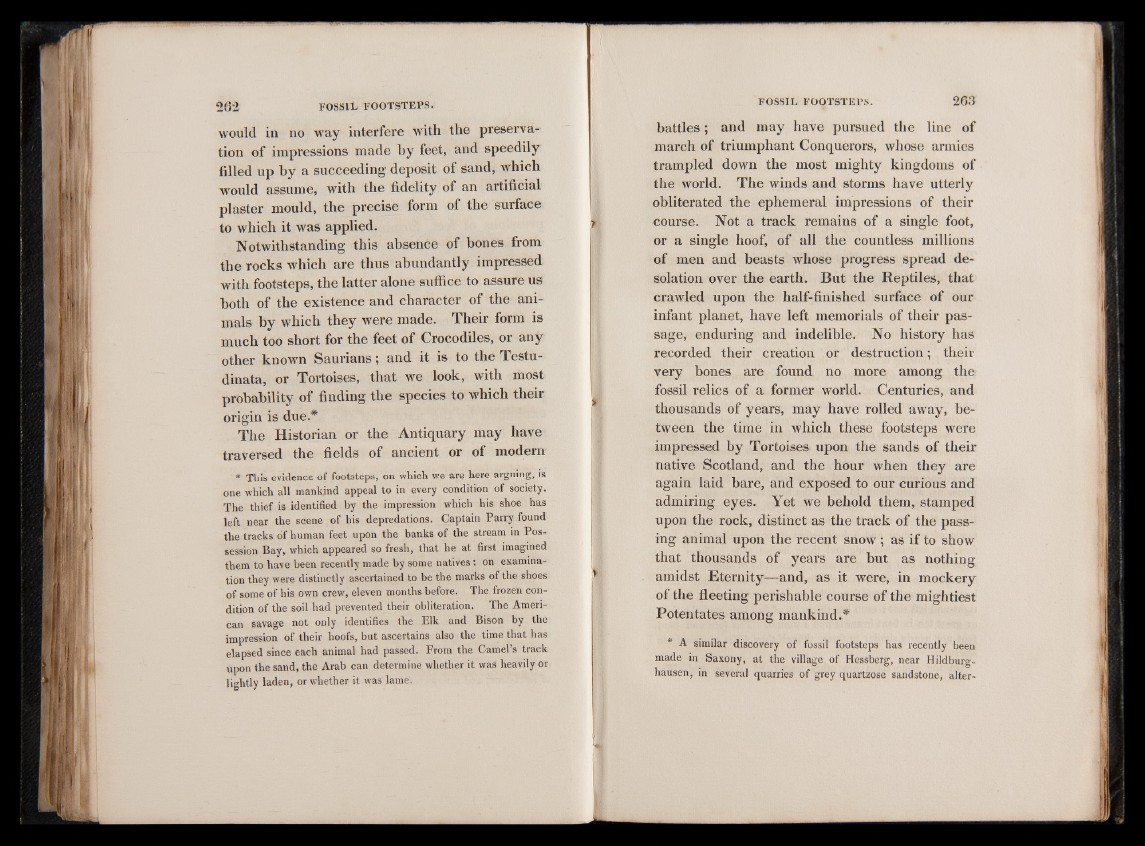
would in no way interfere with the preservation
of impressions made by feet, and speedily
filled up by a succeeding deposit of sand, which
would assume, with the fidelity of an artificial
plaster mould, the precise form of the surface
to which it was applied.
Notwithstanding this absence of bones from
the rocks which are thus abundantly impressed
with footsteps, the latter alone suffice to assure us
both of the existence and character of the animals
by which they were made. Their form is
much too short for the feet of Crocodiles, or any
other known Saurians; and it is to the Testu-
dinata, or Tortoises, that we look, with most
probability of finding the species to which their
origin is due.*
The Historian or the Antiquary may have
traversed the fields of ancient or of modern
* This evidence of footsteps, on which we are here arguing, is
one which all mankind appeal to in every condition of society.
The thief is identified by the impression which his shoe has
left near the scene of his depredations. Captain Parry found
the tracks of human feet upon the banks of the stream in Possession
Bay, which appeared so fresh, that he at first imagined
them to have been recently made by some natives : on examination
they were distinctly ascertained to be the marks of the shoes
of some of his own crew, eleven months before. The frozen condition
of the soil had prevented their obliteration. The American
savage not only identifies the Elk and Bison by the
impression of their hoofs, but ascertains also the time that has
elapsed since each animal had passed. From the Camel’s track
upon the sand, the Arab can determine whether it was heavily or
lightly laden, or whether it was lame.
battles; and may have pursued the line of
march of triumphant Conquerors, whose armies
trampled down the most mighty kingdoms of
the world. The winds and storms have utterly
obliterated the ephemeral impressions of their
course. Not a track remains of a single foot,
or a single hoof, of all the countless millions
of men and beasts whose progress spread desolation
over the earth. But the Reptiles, that
crawled upon the half-finished surface of our
infant planet, have left memorials of their passage,
enduring and indelible. No history has
recorded their creation or destruction; their
very bones are found no more among the
fossil relics of a former world. Centuries, and
thousands of years, may have rolled away, between
the time in which these footsteps were
impressed by Tortoises upon the sands of their
native Scotland, and the hour when they are
again laid bare, and exposed to our curious and
admiring eyes. Yet we behold them, stamped
upon the rock, distinct as the track of the passing
animal upon the recent snow; as if to show
that thousands of years are but as nothing
amidst Eternity— and, as it were, in mockery
of the fleeting perishable course of the mightiest
Potentates among mankind.*
* A similar discovery of fossil footsteps has recently been
made in Saxony, at the village of Hessberg, near Hildburg-
hausen, in several quarries of grey quartzose sandstone, alter